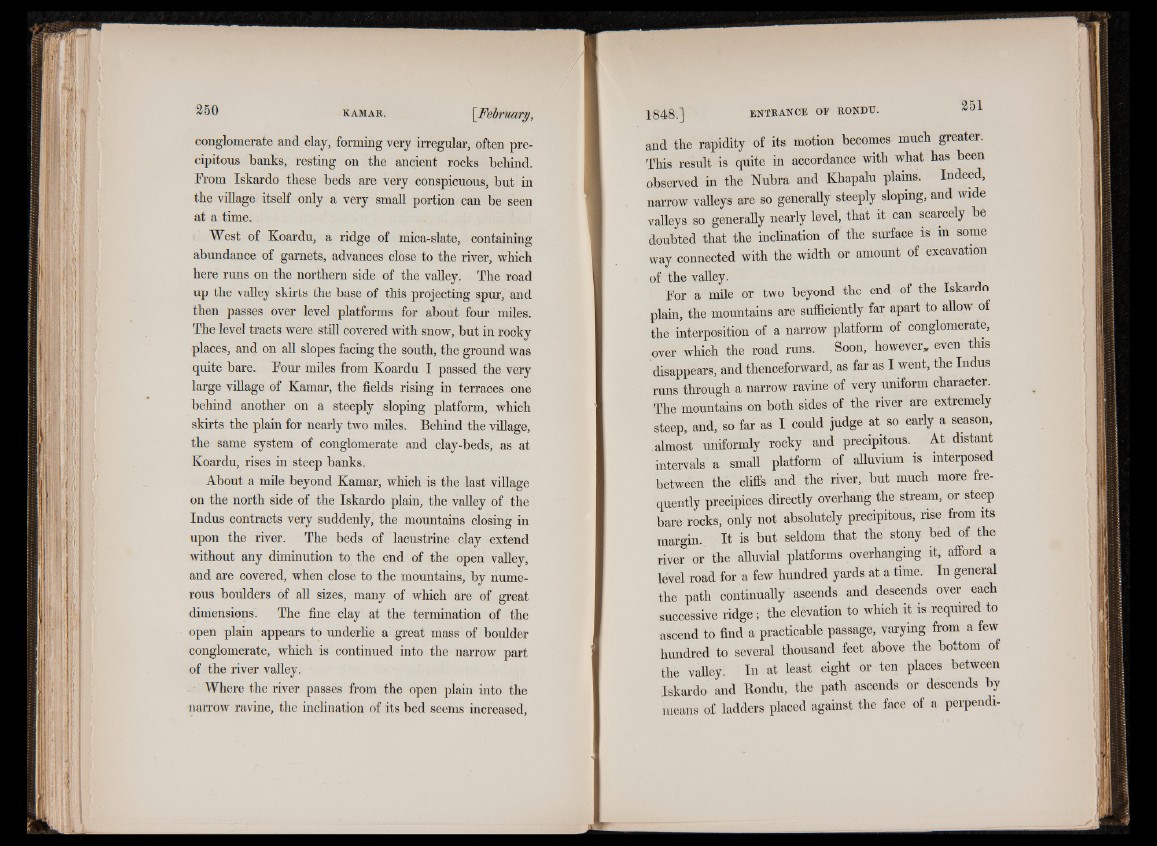
conglomerate and clay, forming very irregular, often precipitous
banks, resting on the ancient rocks behind.
From Iskardo these beds are very conspicuous, but in
the village itself only a very small portion can be seen
at a time.
West of Koardu, a ridge of mica-slate, containing
abundance of garnets, advances close to the river, which
here runs on the northern side of the valley. The road
up the valley skirts the base of this projecting spur, and
then passes over level platforms for about four miles.
The level tracts were still covered with snow, but in rocky
places, and on all slopes facing the south, the ground was
quite bare. Four miles from Koardu I passed the very
large village of Kamar, the fields rising in terraces one
behind another on a steeply sloping platform, which
skirts the plain for nearly two miles. Behind the village,
the same system of conglomerate and clay-beds, as at
Koardu, rises in steep banks.
About a mile beyond Kamar, which is the last village
on the north side of the Iskardo plain, the valley of the
Indus contracts very suddenly, the mountains closing in
upon the river. The beds of lacustrine clay extend
without any diminution to the end of the open valley,
and are covered, when close to the mountains, by numerous
boulders of all sizes, many of which are of great
dimensions. The fine clay at the termination of the
open plain appears to underlie a great mass of boulder
conglomerate, which is continued into the narrow part
of the river valley.
Where the river passes from the open plain into the
narrow ravine, the inclination of its bed seems increased,
and the rapidity of its motion becomes much greater.
This result is quite in accordance with what has been
observed in the Nubra and Khapalu plains. Indeed,
narrow valleys are so generally steeply sloping, and wide
valleys so generally nearly level, that it can scarcely be
doubted that the inclination of the surface is m some
way connected with the width or amount of excavation
of the valley.
For a mile or two beyond the end of the Iskardo
plain, the mountains are sufficiently far apart to allow of
the interposition of a narrow platform of conglomerate,
over which the road runs. Soon, however, even this
disappears, and thenceforward, as far as I went, the Indus
runs through a narrow ravine of very uniform character.
The mountains on both sides of the river are extremely
steep, and, so far as I could judge at so early a season,
almost uniformly rocky and precipitous. At distant
intervals a small platform of alluvium is interposed
between the cliffs and the river, but much more frequently
precipices directly overhang the stream, or steep
bare rocks, only not absolutely precipitous, rise from its
margin. It is but seldom that the stony bed of the
river or the alluvial platforms overhanging it, afford a
level road for a few hundred yards at a time. In general
the path continually ascends and descends over each
successive ridge; the elevation to which it is required to
ascend to find a practicable passage, varying from a few
hundred to several thousand feet above the bottom of
the valley. In at least eight or ten places between
Iskardo and Rondu, the path ascends or descends by
means of ladders placed against the face of a perpendi